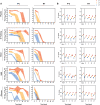Stability of Monkeypox Virus on Commonly Contacted Surfaces in Clinical Settings
- PMID: 40438302
- PMCID: PMC12117650
- DOI: 10.1093/ofid/ofaf225
Stability of Monkeypox Virus on Commonly Contacted Surfaces in Clinical Settings
Abstract
Monkeypox virus (MPXV), the etiologic agent of mpox, is an enveloped DNA virus that may persist on various surfaces, contributing to fomite-mediated transmission. The ongoing global outbreak of mpox has highlighted an urgent need to understand the environmental stability of MPXV. This study investigates the stability of MPXV on surfaces encountered in clinical settings. The persistence of viable MPXV and viral DNA was evaluated using porous (gauze, cotton, and scrubs), and nonporous (stainless steel, polypropylene plastic, intravenous tubing, N95 masks, and nitrile gloves) materials. Surfaces were inoculated with 105, 106, and 107 TCID50 (50% Tissue Culture Infectious Dose) MPXV and incubated at room temperature (22 °C) and 4 °C for up to 21 days to determine the effect of temperature and inoculum titre on virus viability. We show that MPXV stability is influenced by both surface type and temperature, with nonporous surfaces and lower temperatures supporting longer virus viability. Infectious MPXV was detected for up to 21 days on intravenous tubing and nitrile gloves at 4 °C, whereas porous materials like cotton showed rapid loss of infectivity, especially at room temperature. Notably, we found that viral DNA did not correlate with the presence of infectious virus, suggesting that molecular assays may overestimate fomite-mediated transmission risks. Our findings provide novel insights into MPXV persistence in clinical environments, extending prior knowledge by systematically quantifying virus viability across multiple surface types and temperature conditions. These findings underscore the importance of stringent decontamination protocols in clinical settings and highlight the need for comprehensive methods for risk assessment to evaluate the potential for MPXV transmission from contaminated surfaces.
Keywords: mpox; mpox virus; stability; surface; transmission.
© The Author(s) 2025. Published by Oxford University Press on behalf of Infectious Diseases Society of America.
Figures


Similar articles
-
Stability of mpox virus on different commonly contacted surfaces.J Med Virol. 2023 Dec;95(12):e29296. doi: 10.1002/jmv.29296. J Med Virol. 2023. PMID: 38054540
-
Efficacy of Disinfectants for Monkeypox Virus Inactivation on High Touch Surface Materials in Low-Resource Settings.Environ Sci Technol. 2024 Nov 12;58(45):19981-19989. doi: 10.1021/acs.est.4c09821. Epub 2024 Oct 31. Environ Sci Technol. 2024. PMID: 39481121 Free PMC article.
-
Environmental Persistence of Monkeypox Virus on Surfaces in Household of Person with Travel-Associated Infection, Dallas, Texas, USA, 2021.Emerg Infect Dis. 2022 Oct;28(10):1982-1989. doi: 10.3201/eid2810.221047. Epub 2022 Aug 11. Emerg Infect Dis. 2022. PMID: 35951009 Free PMC article.
-
Differences in pathogenicity among the mpox virus clades: impact on drug discovery and vaccine development.Trends Pharmacol Sci. 2023 Oct;44(10):719-739. doi: 10.1016/j.tips.2023.08.003. Epub 2023 Sep 4. Trends Pharmacol Sci. 2023. PMID: 37673695 Review.
-
Transmission of monkeypox/mpox virus: A narrative review of environmental, viral, host, and population factors in relation to the 2022 international outbreak.J Med Virol. 2023 Feb;95(2):e28534. doi: 10.1002/jmv.28534. J Med Virol. 2023. PMID: 36708091 Free PMC article. Review.
References
-
- Rheinbaben FV, Gebel J, Exner M, Schmidt A. Environmental resistance, disinfection, and sterilization of poxviruses. In: Mercer AA Schmidt A and Weber O, eds. Poxviruses. Basel: Birkhäuser Basel, 2007:397–405.
LinkOut - more resources
Full Text Sources

